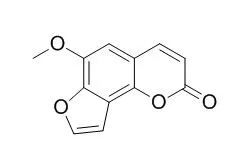| Kinase Assay: |
| Life Sci. 2002 Nov 29;72(2):199-213. | | Effects of sphondin, isolated from Heracleum laciniatum, on IL-1beta-induced cyclooxygenase-2 expression in human pulmonary epithelial cells.[Pubmed: 12417253] | Recently, under large-scale screening experiments, we found that Sphondin, a furanocoumarin derivative isolated from Heracleum laciniatum, possessed an inhibitory effect on IL-1beta-induced increase in the level of COX-2 protein and PGE(2) release in A549 cells. Accordingly, we examined in the present study the action mechanism of Sphondin on the inhibition of IL-1beta-induced COX-2 protein expression and PGE(2) release in a human pulmonary epithelial cell line (A549).
METHODS AND RESULTS:
Pretreatment of cells with Sphondin (10-50 microM) concentration-dependently attenuated IL-1beta-induced COX-2 protein expression and PGE(2) release. The IL-1beta-induced increase in COX-2 mRNA expression was also attenuated by Sphondin (50 microM). The selective COX-2 inhibitor, NS-398 (0.01-1 microM), inhibited the activity of the COX-2 enzyme in a concentration-dependent manner, while Sphondin (10-50 microM) had no effect. Sphondin (50 microM) did not affect the IL-1beta-induced activations of p44/42 MAPK, p38 MAPK, and JNK. Treatment of cells with Sphondin (50 microM) or the NF-kappaB inhibitor, PDTC (50 microM) partially inhibited IL-1beta-induced degradation of IkappaB-alpha in the cytosol and translocation of p65 NF-kappaB from the cytosol to the nucleus. Furthermore, IL-1beta-induced NF-kappaB-specific DNA-protein complex formation in the nucleus was partially inhibited by Sphondin (50 microM) or PDTC (50 microM).
CONCLUSIONS:
Taken together, we demonstrate that Sphondin inhibits IL-1beta-induced PGE(2) release in A549 cells; this inhibition is mediated by suppressing of COX-2 expression, rather than by inhibiting COX-2 enzyme activity. The inhibitory mechanism of Sphondin on IL-1beta-induced COX-2 expression may be, at least in part, through suppression of NF-kappaB activity. We conclude that Sphondin may have the therapeutic potential as an anti-inflammatory drug on airway inflammation. | | Bioorg Med Chem. 2000 Dec;8(12):2701-7. | | Inducible nitric oxide synthase inhibitors of Chinese herbs. Part 2: naturally occurring furanocoumarins.[Pubmed: 11131161] | Inducible nitric oxide synthase (iNOS)-dependent production of nitric oxide (NO) plays an important role in inflammation.
METHODS AND RESULTS:
The effects of various naturally occurring furanocoumarins on NO production in lipopolysaccharide (LPS)-activated RAW 264.7 macrophage cells were evaluated in vitro. The results showed that angelicin, pimpinellin, Sphondin, byakangelicol, oxypeucedanin, oxypeucedanin hydrate, xanthotoxin, and cnidilin are potential NO production inhibitors, and their IC50 values for inhibition of nitrite production were 19.5, 15.6, 9.8, 16.9, 16.8, 15.8, 16.6, and 17.7 microg/mL, respectively. Distinct structure-activity relationships were also revealed for the NO production inhibitory activities of these furanocoumarins. Activities of the angelicin type such as pimpinellin and Sphondin were more potent than those of the psoralen type. Presence of a methoxy at the C6 position in the angelicin type seemed to be essential to augment the activity. Western blot analysis demonstrated that only Sphondin dose-dependently inhibited the expression of the iNOS protein at 2.5-20 microg/mL. However, iNOS enzyme activity was stimulated with LPS for 12 h and Sphondin was administered (20 microg/mL) for 24 h, which did not reasonably inhibit iNOS enzyme activity. L-NAME (100 microM), a known specific inhibitor of iNOS, was employed as a positive control with the same protocol and showed more than 50% inhibition activity.
CONCLUSIONS:
The results demonstrate that the NO production inhibitory activity of Sphondin is due to the effect of iNOS expression, but not by direct inhibition of iNOS enzyme activity. Thus, Sphondin may act as a potent inhibitor of NO production under tissue-damaging inflammatory conditions. |
|
| Animal Research: |
| J Chem Ecol. 1986 Apr;12(4):899-914. | | Delayed phototoxic effects of 8-methoxypsoralen, khellin, and sphondin inAedes aegypti.[Pubmed: 24306978 ] |
METHODS AND RESULTS:
At concentrations up to 6.7 ppm, 8-methoxypsoralen, Sphondin, and khellin are not toxic to first-instar larvae of the mosquitoAedes aegypti. The irradiation of sensitized larvae with long-wavelength ultraviolet light did not always produce any immediate toxicity enhancement, but delayed effects were clearly visible. These were observed over the development of the organisms from first-instar larvae to adults. No adverse effects were noted when larvae were irradiated in the absence of sensitizers, or when they were placed in solutions of sensitizers which had been previously irradiated with the same light sources.
CONCLUSIONS:
8-Methoxypsoralen was slightly more phototoxic than its isomer Sphondin. Khellin, recently reported to undergo photoinduced cyclization with DNA components, showed minimal phototoxicity in the concentration range used. |
|






 Cell. 2018 Jan 11;172(1-2):249-261.e12. doi: 10.1016/j.cell.2017.12.019.IF=36.216(2019)
Cell. 2018 Jan 11;172(1-2):249-261.e12. doi: 10.1016/j.cell.2017.12.019.IF=36.216(2019) Cell Metab. 2020 Mar 3;31(3):534-548.e5. doi: 10.1016/j.cmet.2020.01.002.IF=22.415(2019)
Cell Metab. 2020 Mar 3;31(3):534-548.e5. doi: 10.1016/j.cmet.2020.01.002.IF=22.415(2019) Mol Cell. 2017 Nov 16;68(4):673-685.e6. doi: 10.1016/j.molcel.2017.10.022.IF=14.548(2019)
Mol Cell. 2017 Nov 16;68(4):673-685.e6. doi: 10.1016/j.molcel.2017.10.022.IF=14.548(2019)